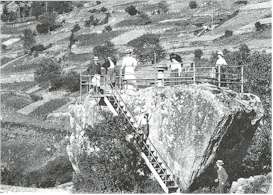Milestones:Marconi's Early Experiments in Wireless Telegraphy, 1895 and Milestones:Revoked: Difference between pages
No edit summary |
No edit summary |
||
| Line 1: | Line 1: | ||
' | == Marconi's Early Wireless Experiments, 1895 == | ||
Salvan, Switzerland - 26 September 2003 - [[IEEE Switzerland Section History|IEEE Switzerland Section]] | |||
[[Image:Marconi's Early Wireless Experiments use this one for actual milestone page.jpg|thumb]] | |||
''On this spot in 1895, with local assistance, [[Guglielmo Marconi]] carried out some of the first [[Wireless Telegraphy|wireless]] experiments. He first transmitted a signal from this "Shepherdess Stone" over a few meters and later, following one and a half months of careful adjustments, over a distance of up to one and a half kilometers. | |||
This was the beginning of Marconi´s pivotal involvement in wireless radio.'' | |||
The | '''The plaque can be viewed in the town of Salvan, Switzerland, attached to the famous Shepherdess Stone.''' | ||
The village of Salvan, Switzerland was known in the last years of the 19th century as a health resort. Located in the southwest of Switzerland in the Swiss Alps, very close to the France border, it was accessible only by a narrow mule path, nicknamed "route de Mont". Marconi, at the age of 21, visited Salvan in the Summer of 1895. It was suggested that he visited the resort to treat a respiratory ailment. | |||
Marconi's equipment consisted of a [[Batteries|battery]], a Ruhmkorff induction coil, a Righi spark generator and an antenna. His goal: transmit a signal without a metallic connection. He set up his experiments on Pierre Bergère (the Shepherdess Stone). Marconi was operating the transmitter, and a young assistant*, a resident of Salvan, began to move the receiver, which sounded a bell, farther away. First the distance was approximately four or five meters. The final distance in which the experiment worked was approximately one and a half kilometers. Each time the bell sounded the young assistant would hold up a red flag; when it did not he would hold up a white flag. (The accounts of the actual distance vary.) These experiments continued for several weeks. | |||
Marconi only spent a short time in Salvan, then returned to Italy. The following year he filed the original patent on his invention in London. | |||
Much of this information was obtained some 70 years after the event, from the young assistant, Maurice Gay-Balmaz, who was 10 years old at the time of the experiment. | |||
== Map == | == Map == | ||
{{#display_map: | {{#display_map:46.12164, 7.02161~ ~ ~ ~ ~Salvan, Switzerland|height=250|zoom=10|static=yes|center=46.12164, 7.02161}} | ||
[[Category:Communications|{{PAGENAME}}]] | |||
[[Category:Radio_communication|{{PAGENAME}}]] | |||
[[Category:Telegraphy|{{PAGENAME}}]] | |||
[[Category:Wireless_telegraphy|{{PAGENAME}}]] | |||
Revision as of 17:49, 6 January 2015
Marconi's Early Wireless Experiments, 1895
Salvan, Switzerland - 26 September 2003 - IEEE Switzerland Section
On this spot in 1895, with local assistance, Guglielmo Marconi carried out some of the first wireless experiments. He first transmitted a signal from this "Shepherdess Stone" over a few meters and later, following one and a half months of careful adjustments, over a distance of up to one and a half kilometers. This was the beginning of Marconi´s pivotal involvement in wireless radio.
The plaque can be viewed in the town of Salvan, Switzerland, attached to the famous Shepherdess Stone.
The village of Salvan, Switzerland was known in the last years of the 19th century as a health resort. Located in the southwest of Switzerland in the Swiss Alps, very close to the France border, it was accessible only by a narrow mule path, nicknamed "route de Mont". Marconi, at the age of 21, visited Salvan in the Summer of 1895. It was suggested that he visited the resort to treat a respiratory ailment.
Marconi's equipment consisted of a battery, a Ruhmkorff induction coil, a Righi spark generator and an antenna. His goal: transmit a signal without a metallic connection. He set up his experiments on Pierre Bergère (the Shepherdess Stone). Marconi was operating the transmitter, and a young assistant*, a resident of Salvan, began to move the receiver, which sounded a bell, farther away. First the distance was approximately four or five meters. The final distance in which the experiment worked was approximately one and a half kilometers. Each time the bell sounded the young assistant would hold up a red flag; when it did not he would hold up a white flag. (The accounts of the actual distance vary.) These experiments continued for several weeks.
Marconi only spent a short time in Salvan, then returned to Italy. The following year he filed the original patent on his invention in London.
Much of this information was obtained some 70 years after the event, from the young assistant, Maurice Gay-Balmaz, who was 10 years old at the time of the experiment.
